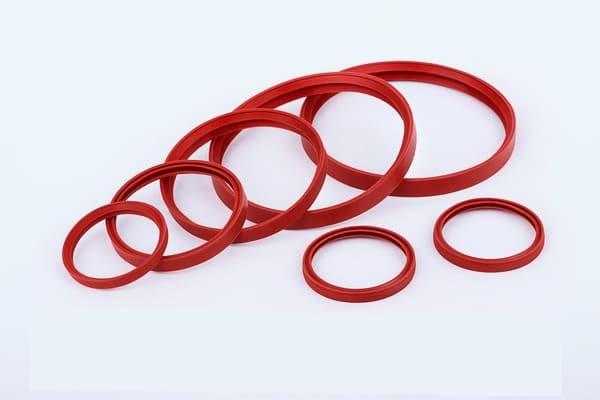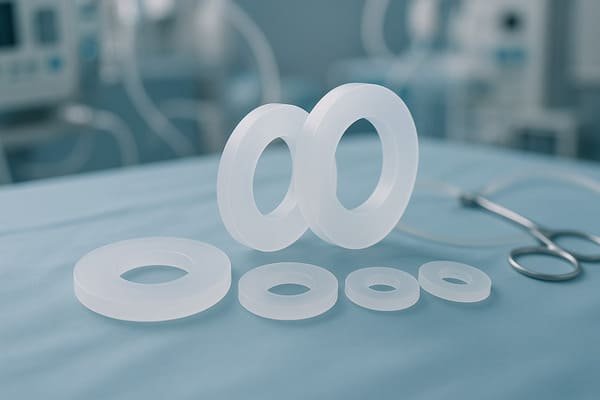I know the stress when production stops because of a small gasket and you do not know which supplier you can really trust.
You can buy custom silicone rubber gaskets from local converters, industrial distributors, online platforms, and direct-from-factory OEM suppliers. The best choice depends on your volume, temperature range, certifications, and how stable your design is.

When I guide purchasing teams, I always start from their real project: is it a one-time urgent job, or a long-term OEM product? After that, the right channel usually becomes very clear and the risk drops a lot.
Should I buy custom silicone gaskets from local converters or distributors?
Sometimes I see buyers pay high prices to local suppliers, but they still accept it because they fear quality problems from overseas. I went through the same stage many years ago.
You choose local converters and distributors when you need fast lead time, small quantities, or simple shapes from standard silicone sheet. You pay more per piece, but you reduce risk and you gain speed and easy communication.
What local converters really do
Local gasket converters usually start from silicone sheet1 or roll stock. They use die cutting2, waterjet cutting3, or flash cutting4 to make flat gaskets. They can handle common grades like general purpose silicone and food-grade silicone5 that meets FDA 21 CFR 177.26006, so these parts are safe for many food and beverage systems.
Silicone has one of the widest operating temperature7 windows among elastomers. In many datasheets, you see typical continuous ranges from about −55 °C to +200 °C, and some special grades run even higher for short periods. This makes silicone a safe choice for HVAC, ovens, and sterilization lines where other rubbers fail.
When I speak with local converters8 in Europe, they tell me that most customers stay in the 40–70 Shore A hardness9 range. This range gives a good balance of flexibility and strength, so gaskets compress well but still hold shape under load. Shore A is the standard scale for most flexible rubbers, so this also fits most test labs and inspection tools.
The main problem is cost. Labor, rent, and inventory are expensive for local companies. So the unit price is high when you repeat orders over many years. Local converters shine in the early phase of a project, but once the design is fixed and the volume grows, I often help buyers move the main volume to a dedicated molding factory10 and keep the converter only for emergency or specialty work.
Pros and cons of local converters and distributors
| ✅ Point / ❌ Risk | Local converters | Industrial distributors |
|---|---|---|
| ✅ Speed | Very fast for prototypes and spares | Fast, stock-based |
| ✅ Communication | Same language and time zone | Simple ordering, clear catalog data |
| ✅ Low starting cost | Often no mold, low setup | No mold, buy from shelf |
| ❌ Unit price | High at medium or large volumes | Medium to high |
| ❌ Shape limits | Mostly 2D cut parts | Mostly standard sizes |
| ❌ Custom materials | Limited custom compounding | Limited to catalog materials |
When I help a new customer, I seldom suggest that they cut off their local supplier completely. Instead, I see local converters as a strong part of a mixed model: they handle urgent, small, and complex one-off work, while a factory like mine supports stable, larger production with molds and better long-term cost.
Is it safe to buy custom silicone gaskets11 from online platforms and marketplaces?
Many buyers go to online platforms first because everything looks fast and cheap. Then they receive gaskets that smell strange, leak, or fail under heat. I have been called many times to fix these problems.
It is safe to buy custom silicone gaskets from online platforms only if you treat the platform as a directory, then deeply verify the factory, the material, and the documents before you place real orders.

How I screen online suppliers
B2B platforms and marketplaces list thousands of “silicone gasket suppliers”. I do not trust the search result labels. I use them as a starting point. I first filter by the process I need: molded parts, extruded profiles, or die-cut sheet. I also check if they mention real standards, like ISO 900112, IATF 16949 for automotive, or FDA 21 CFR 177.2600 for food applications.
Then I move the real conversation to email or video call. I ask who owns the factory, how many compression presses they run, and what their main export markets are. If a supplier claims experience with high temperature gaskets, I ask for actual data, such as continuous working range and short-term peak. Many serious silicone factories describe ranges like −60 °C to +230 °C for general grades and even higher for special high-temperature compounds. That tells me they know their material.
✅ I also look at hardness options. Real silicone grade lists show wide hardness ranges from very soft (around 10–20 Shore A) to very firm (80–90 Shore A). This matches independent databases that show silicone grades across almost the full Shore A scale. If a “factory” only offers one or two generic hardness options, it often means they are a trader.
Practical checklist you can reuse
I use a simple checklist with every new online supplier. You can reuse it in your next project:
| Factor | What I ask for | Why it matters |
|---|---|---|
| Company identity | Full legal name, address, business license scan | Confirms they are a real company, not just a mailbox |
| Process capability | Photos of presses, mixing, tool shop, packing line | Shows if they truly produce gaskets |
| Material data | TDS with hardness, tensile strength, elongation, and working temperature | Confirms that silicone grade fits your design window |
| Certifications | ISO 9001; FDA 21 CFR 177.2600 or EU food contact if needed | Keeps you safe for audits and food or pharma projects |
| Chemical resistance | Compatibility charts or experience with your medium (water, oils, solvents) | Reduces risk of swelling, cracking, or leakage |
| Sample policy | Number of free or paid samples, lead time for samples | Allows you to validate real parts before large orders |
| Traceability | Batch numbers and test reports with each shipment | Makes complaints and root-cause analysis much easier |
I always insist on a small, paid sample order before any big move. In that step, I check dimensions, hardness, smell, compression set13, and visual defects. If the supplier passes this step and keeps promises on lead time and communication, only then do I suggest a larger order.
This approach takes more time in the beginning, but it saves a lot of time and money later. It keeps you away from hidden fillers, wrong hardness, or fake “food-grade” claims that do not actually meet any standard.
When does buying directly from a Chinese silicone gasket factory make sense?
Some buyers still think direct factory sourcing only fits huge volumes and very large brands. In my daily work, I see many mid-sized projects gain real benefits when they choose the right factory partner early.
Buying directly from a Chinese silicone gasket factory makes sense when your design is stable, your annual demand can justify a mold, and you care about long-term cost, material tuning, and technical support.

When volume justifies tooling
Custom molding needs tooling. At first, the mold fee14 may look like a barrier. I always sit down with the buyer and do simple math. We compare the cost per piece from local cutting versus molded parts from our factory. Often, the mold pays itself back after one or two large orders.
Silicone gaskets for HVAC, food equipment, and machinery often run in the thousands or tens of thousands per year. For this level, molded production brings a stable unit cost and better control of complex features like lips, grooves, or integrated ribs. It also opens the door to sponge silicone options when the design needs very low compression force.
In my factory, we also combine different gasket sizes into one mold family when the design allows it. This reduces total tooling cost and makes the project more flexible. ✅ When a buyer can accept a slightly higher first order for filling the mold, we can offer a better price per piece for the whole long-term program.
Key selection standards: temperature, hardness, certification, chemical compatibility
When a buyer asks me to quote molded silicone gaskets, I always walk through four key selection standards. These same points help you decide if a factory is really thinking like a partner:
1. Temperature range
Silicone is famous for its temperature resistance15. Many technical sources describe stable ranges from around −60 °C up to +230 °C for common grades, and some special compounds work up to about +260 °C or short peaks near +300 °C. These ranges are far beyond many other rubbers, so silicone fits ovens, sterilization, and cold environments.
I ask the buyer to share both normal working temperature and peak events, such as cleaning cycles, baking, or defrosting. Then I confirm with our compounder that the selected grade can handle this window with enough safety margin.
2. Hardness and mechanical behavior
Next, we choose hardness. Most practical gaskets fall into the 40–80 Shore A band. Lower hardness gives softer sealing and easier compression, while higher hardness gives more shape stability and wear resistance. Independent charts show silicone can span almost the entire Shore A scale, so we can usually tune it for your design.
I also check flange forces and bolt patterns. This helps me see if a softer grade will avoid over-stressing plastic housings, or if a firmer grade is needed to resist extrusion at high pressure.
3. Certifications and regulations
For food, beverage, and pharma systems, I always ask if they need FDA or EU food contact. FDA 21 CFR 177.2600 is the key regulation that defines rubber articles intended for repeated food contact. It sets extraction limits in water and in fatty simulants, so it protects the end user from unwanted migration. ✅
Some buyers also ask for EU 1935/2004, or even USP Class VI for medical devices. In these cases, I select certified grades and plan a clear document package: material certificate, extraction test report, and a declaration of compliance. This helps them pass audits later without extra stress.
4. Chemical compatibility
Finally, we look at the medium. Silicone is usually excellent with water, steam, and many polar fluids. It can also handle many acids and bases, but it is weaker with some fuels, oils, and non-polar solvents. Good chemical resistance16 charts group performance into levels like excellent, good, fair, or poor for each chemical.
I ask for a list of cleaning agents, CIP chemicals, oils, and any process fluids. Then we check those against compatibility charts17 and our past projects. Sometimes silicone is perfect. Sometimes, if there is heavy oil or fuel exposure, I suggest another rubber like FKM or a different design for the gasket.
When all four standards line up, a direct factory relationship becomes very powerful. I can help set realistic lead times, safety stocks, and packing methods. We can agree on clear inspection plans and, if needed, a simple PPAP-style package. If you want this kind of support, you can always reach me at info@rubberandseal.com or through Julong Rubber.
Conclusion
You can buy custom silicone rubber gaskets from local suppliers, online platforms, and direct factories; the best path depends on your real project, your risk tolerance, and your long-term volume.
-
Explore the advantages of silicone sheets in gasket production, including durability and versatility. ↩
-
Learn about die cutting techniques and their efficiency in producing precise gaskets. ↩
-
Discover the precision and flexibility of waterjet cutting in creating custom gaskets. ↩
-
Understand the flash cutting process and its applications in producing gaskets. ↩
-
Find out why food-grade silicone is crucial for safety in food and beverage applications. ↩
-
Explore the FDA regulations that ensure silicone materials are safe for food contact. ↩
-
Learn about the impressive temperature range of silicone gaskets and their applications. ↩
-
Discover the benefits of working with local converters for quick and customized gasket solutions. ↩
-
Understand the significance of Shore A hardness in determining gasket performance. ↩
-
Find out when it makes sense to transition to a molding factory for larger gasket production. ↩
-
Learn how to safely purchase custom silicone gaskets from online platforms. ↩
-
Understand the importance of ISO 9001 certification in ensuring quality in manufacturing. ↩
-
Learn about compression set and its impact on the performance of silicone gaskets. ↩
-
Learn how mold fees can affect the overall cost of producing silicone gaskets. ↩
-
Find out how silicone gaskets perform under extreme temperature conditions. ↩
-
Learn about methods to test and ensure chemical resistance in silicone gaskets. ↩
-
Understand how compatibility charts assist in selecting the right materials for gaskets. ↩








